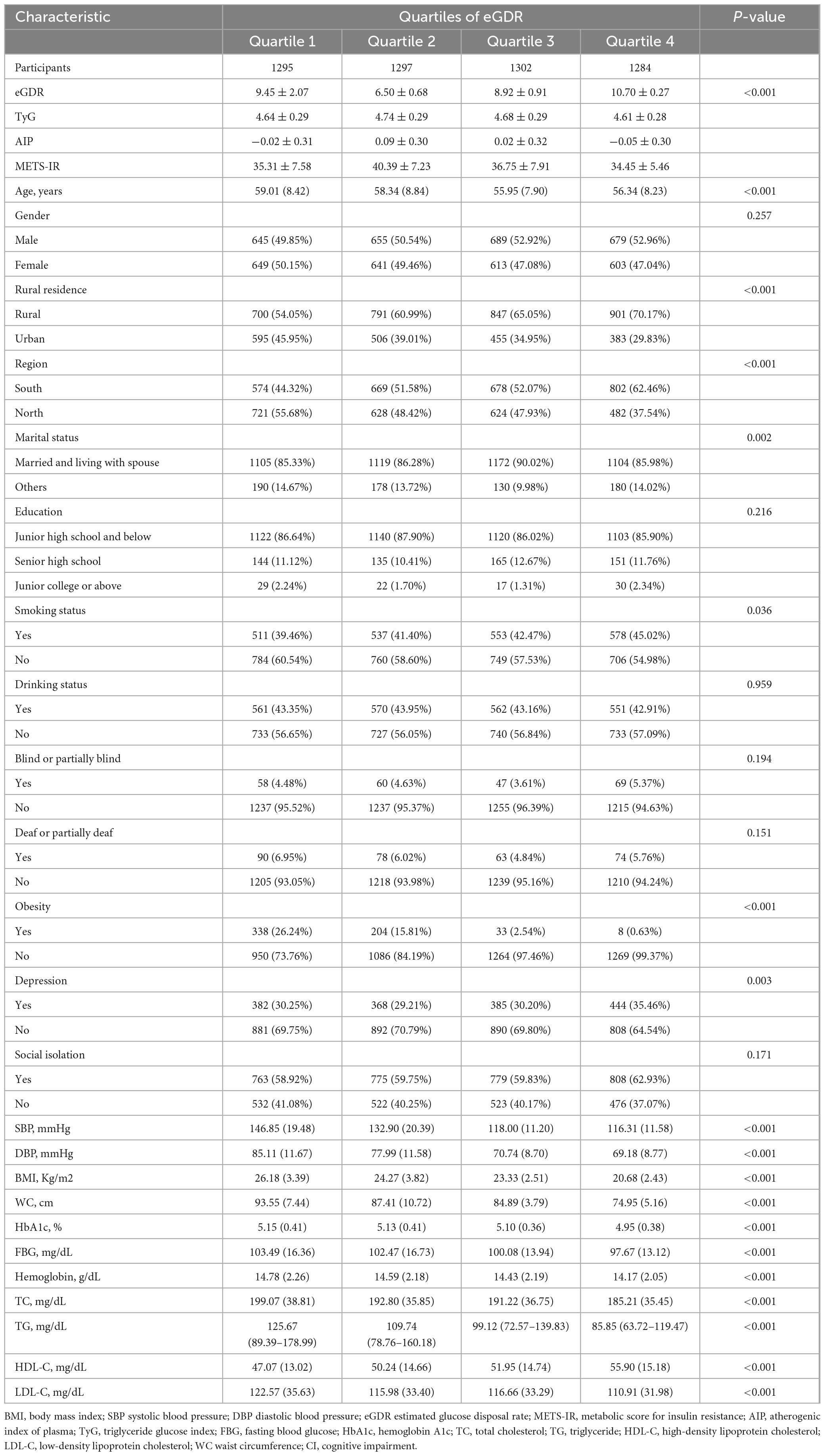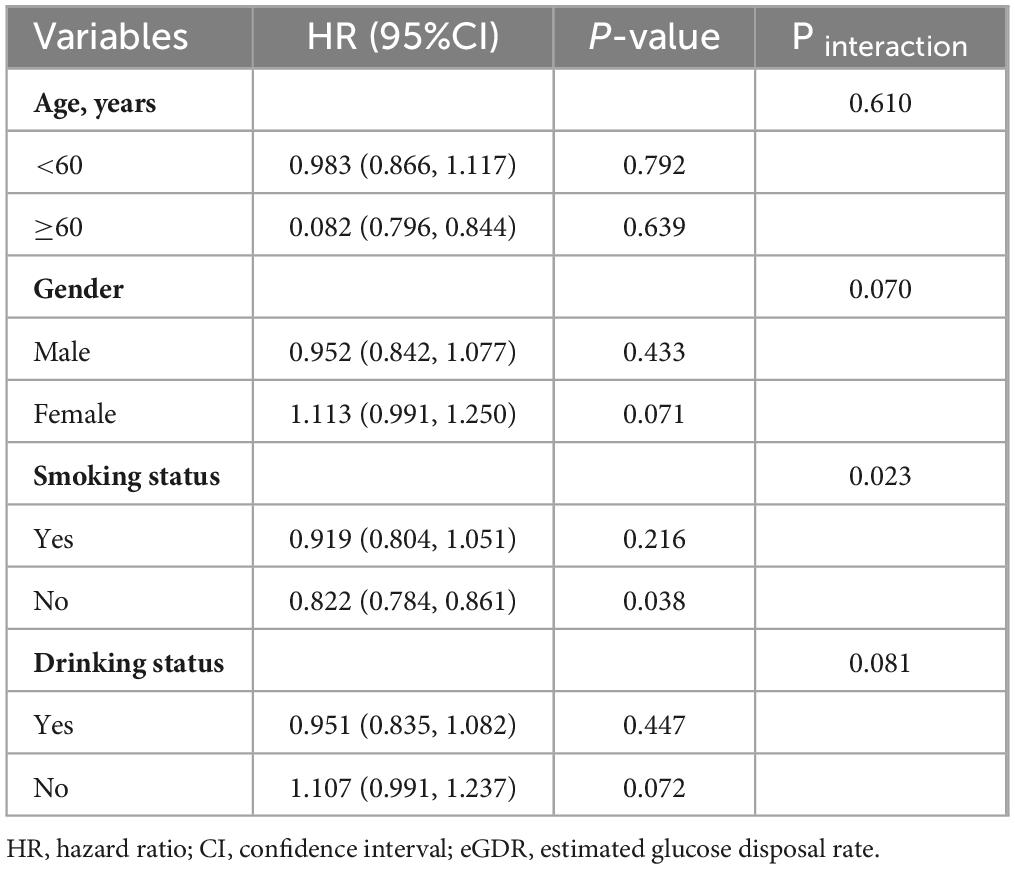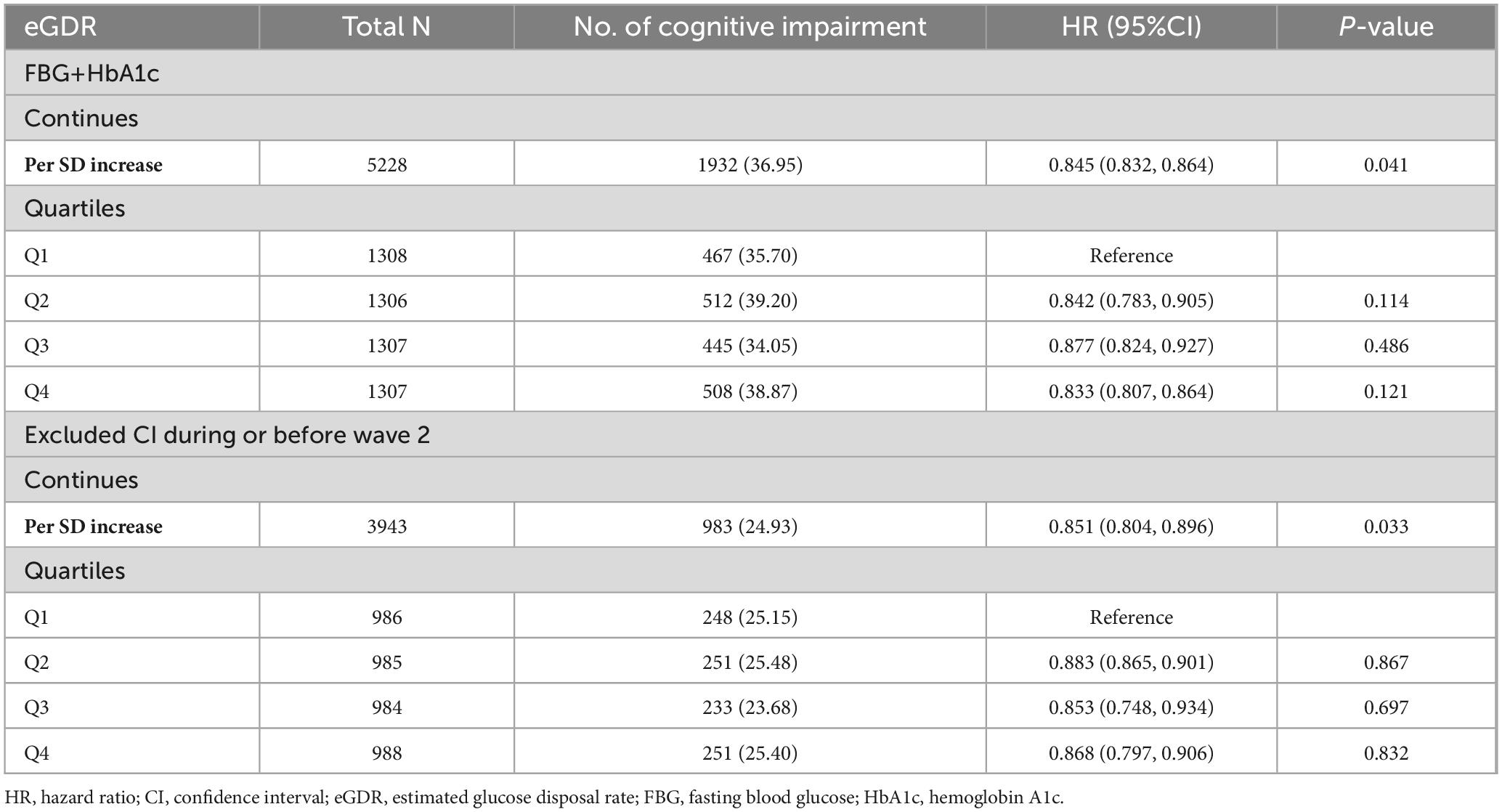- 1Department of Neurology, Taiyuan Central Hospital, Taiyuan, Shanxi, China
- 2Department of Gerontology, The First People’s Hospital of Jinzhong, Jinzhong, Shanxi, China
Background: Emerging evidence suggests insulin resistance may contribute to neurodegeneration, yet its role in non-diabetic populations remains unclear. This study explores the relationship between estimated glucose disposal rate (eGDR), a measure of insulin sensitivity, and incident cognitive dysfunction in non-diabetic adults.
Methods: Our longitudinal analysis utilized data from 5,178 CHARLS participants (age ≥ 45 years). Insulin sensitivity was quantified using eGDR, calculated from waist circumference, hypertension status, and hemoglobin A1c levels. Participants were stratified by eGDR quartiles for comparative analysis. We employed multivariable Cox models, survival curves, restricted cubic splines, and sensitivity testing to evaluate associations with cognitive outcomes.
Results: Over an 8.7-year follow-up, cognitive dysfunction developed in 36.9% of participants. Analyses revealed significant metabolic-cognitive associations, with each standard deviation increase in eGDR linked to a 15.8% reduction in risk (adjusted hazard ratio [HR] = 0.792, 95% confidence interval [CI]: 0.793–0.881). Restricted cubic spline analysis identified non-linear threshold effects, with risk accelerating below certain eGDR levels (P < 0.05). Kaplan-Meier survival analysis demonstrated significant differences in cognitive impairment incidence across eGDR quartiles (P = 0.003). Additionally, both eGDR and metabolic score for insulin resistance (METS-IR) showed comparable predictive value for cognitive impairment risk, outperforming other metabolic indices, including the atherogenic index of plasma (AIP), and the triglyceride glucose index (TyG).
Conclusion: These findings position eGDR as a promising biomarker for cognitive risk stratification in non-diabetic adults. However, further multi-database studies should validate these associations and explore the underlying mechanisms.
Introduction
The rising prevalence of cognitive impairment poses a significant public health burden, intensified by shifting age demographics worldwide. This complex condition arises from an interplay of hereditary factors, environmental influences, and lifestyle variables. Of particular interest is insulin resistance (IR), which has gained attention as a modifiable factor linked to progressive cognitive decline (1–3). Although traditionally viewed through the lens of metabolic disease and Type 2 diabetes mellitus (T2DM), contemporary research establishes IR as an independent predictor of cognitive dysfunction even in individuals with normal glucose regulation (3–6). These findings align with insulin’s diverse neurological functions, including its involvement in brain energy homeostasis, synaptic maintenance, and neuroprotective mechanisms. Mounting evidence further implicates disrupted insulin pathways in the development of Alzheimer’s pathology and other neurodegenerative disorders.
Current diagnostic approaches for IR evaluation, which primarily rely on fasting blood glucose (FBG) and hemoglobin A1c (HbA1c) measurements, demonstrate diminished reliability in non-diabetic populations (7–10). Such metrics often fail to detect early metabolic disturbances occurring outside pancreatic regulation. eGDR, a novel composite index combining abdominal obesity, hypertensive status, and glycemic control parameters, presents a more robust solution. Prior investigations have primarily concentrated on diabetic subjects, potentially obscuring IR’s true effects through glucose-related confounding variables while also facing sample size limitations. Importantly, this innovative measure shows superior accuracy in detecting metabolic dysfunction among populations with preserved glucose tolerance (11, 12) and effectively forecasts cardiovascular-metabolic disease trajectories (13–15). Nevertheless, the connection between eGDR and cognitive performance remains unexplored. Clarifying this relationship may provide valuable tools for identifying high-risk subgroups and implementing timely preventive measures in metabolically vulnerable, non-diabetic individuals.
Utilizing the China Health and Retirement Longitudinal Study (CHARLS) dataset, this research examines how eGDR correlates with newly developed cognitive dysfunction in non-diabetic individuals. Additionally, the analysis compares the eGDR with three contemporary metabolic markers: the metabolic score for insulin resistance (METS-IR), the atherogenic index of plasma (AIP), and the triglyceride glucose index (TyG), in order to assess their respective prognostic capacities for predicting cognitive impairment. These investigations seek to clarify the role of insulin resistance and lipid metabolism in cognitive aging while establishing potential diagnostic applications for eGDR in metabolically at-risk, non-diabetic cohorts.
Materials and methods
Study population
This study draws upon data from the CHARLS, a nationally representative cohort study initiated in 2011, with subsequent follow-up waves in 2013, 2015, 2018, and 2020 (16). A total of 12,527 participants were excluded based on the following criteria: missing data on eGDR (n = 7,767); a diagnosis of DM in 2011 (n = 1,486); a history of brain injury, intellectual disability, stroke, or memory impairment, or incomplete information (n = 524); a diagnosis of cognitive impairment or missing cognitive impairment data in 2011 (n = 2,490); age under 45 years (n = 124); or loss to follow-up (n = 136). Following these exclusions, the final sample comprised 5,178 eligible participants (Figure 1). All study participants provided written informed consent before enrollment. This research project received ethical approval from Peking University’s Biomedical Ethics Review Committee (IRB00001052-11015), with data collection strictly limited to consenting individuals for final analysis.
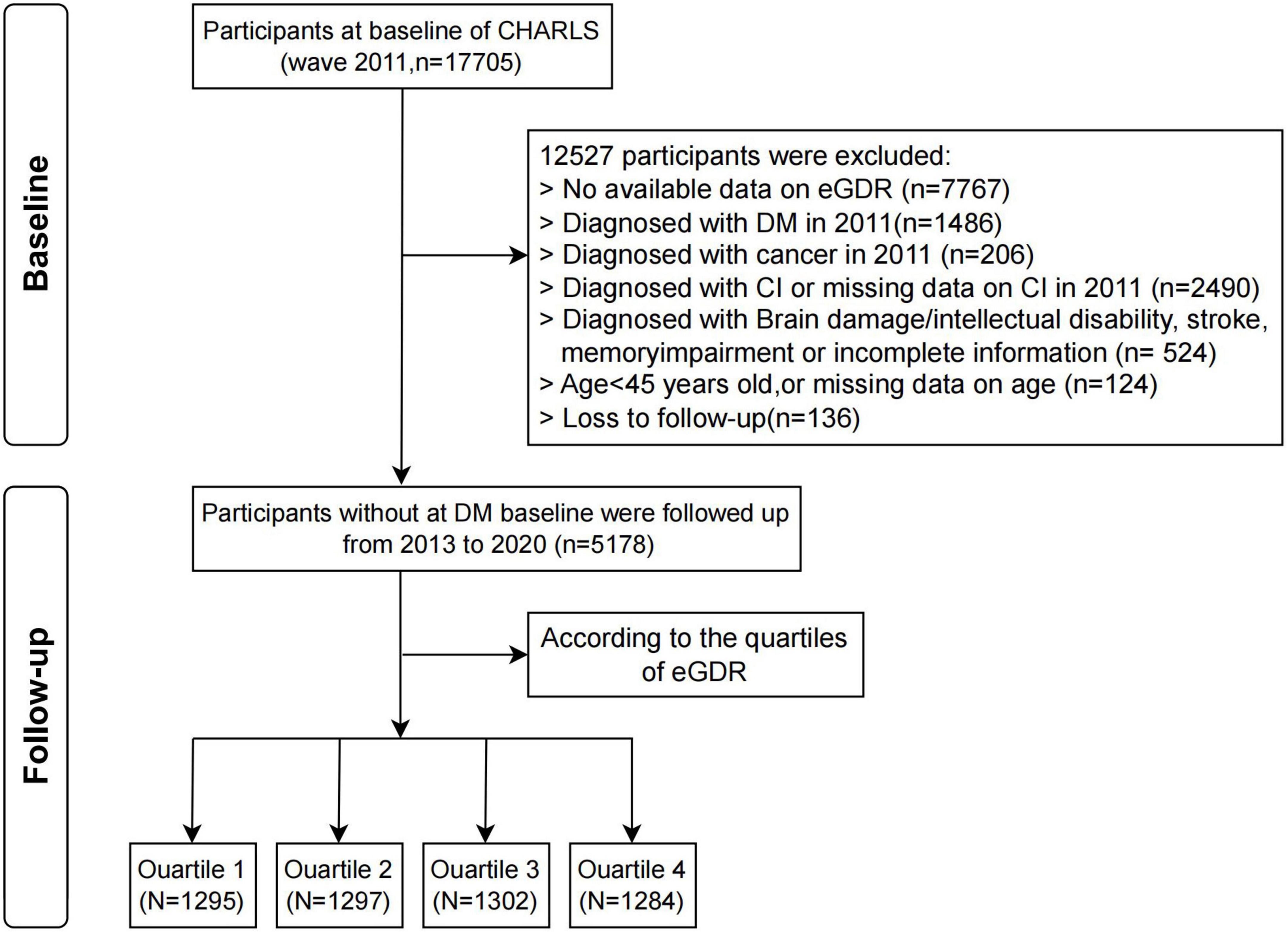
Figure 1. Participant selection process flowchart. eGDR, estimated glucose disposal rate; CI, cognitive impairment; CHARLS, China Health and Retirement Longitudinal Study; DM, diabetes mellitus.
Calculation of eGDR and IR stratification
The estimated glucose disposal rate was derived from the equation: eGDR (mg/kg/min) = 21.158-(0.09 × waist circumference [cm])-(3.407 × hypertension [1 = yes, 0 = no])-(0.551 × hemoglobin A1c) [%]). Participants were then stratified by eGDR quartiles for insulin resistance level comparisons.
Cognitive function assessment in CHARLS
The CHARLS employed the Mini-Mental State Examination (MMSE) to measure cognitive performance, utilizing this standardized tool’s capacity to evaluate both global functioning and specific domains including memory retention and cognitive processing. For memory assessment, researchers administered a ten-item verbal recall test, with participants required to repeat words both immediately following presentation and after a 5-min delay, where one point was allocated for each accurate response (potential score: 0–20). The evaluation of fundamental cognitive capacities incorporated three components: arithmetic tasks involving successive subtraction from 100, geometric figure replication to assess spatial reasoning, and temporal awareness questions regarding date identification. Performance on these measures contributed equally to a maximum of 11 points. By aggregating results from both domains (total possible: 31 points), investigators identified cognitive impairment using a validated cutoff of <11 points (17, 18).
Potential covariates
This investigation expanded upon existing literature by incorporating a multidimensional array of covariates spanning sociodemographic attributes, health behaviors, and clinical biomarkers. Participant profiles captured age, sex, residential classification (urban/rural), geographical location (northern/southern China), educational background (categorized as ≤9 years, 10–12 years, or ≥13 years of schooling), and partnership status (married/cohabiting versus single/divorced/widowed). Health behavior indicators documented tobacco use, alcohol consumption, and sensory impairments, alongside psychosocial factors (social engagement levels and depressive symptoms) and cardiometabolic risk markers (elevated blood pressure and adiposity). Biochemical analyses quantified glycemic control (HbA1c, fasting blood glucose [FBG]), hematologic parameters (hemoglobin), and lipid profiles (total cholesterol [TC], triglycerides [TG], high-density lipoprotein cholesterol [HDL-C], low-density lipoprotein cholesterol[LDL-C]). Adiposity was determined via body mass index (BMI) (weight[kg]/height[m]2), classifying obesity at ≥28 kg/m2. Hypertension criteria included: (1) clinical diagnosis, (2) antihypertensive medication use, or (3) systolic/diastolic pressures exceeding 140/90 mmHg. Diabetes mellitus was operationalized through: (1) self-reported diagnosis, (2) glucose-lowering drug use, (3) FPG ≥ 126 mg/dL (7.0 mmol/L), or 4) HbA1c ≥ 6.5%. Depressive symptomatology was evaluated using the CESD-10 instrument (score range: 0–30 points).
Statistical analysis
Comparisons across eGDR quartiles were conducted to examine variations in demographic, health, and metabolic characteristics, including age, sex, education, marital status, rural residence, geographic region, BMI, WC, systolic blood pressure (SBP), diastolic blood pressure (DBP), obesity, smoking, alcohol use, hemoglobin, FBG, vision impairment, HbA1c, TC, TG, HDL, LDL, diabetes, hearing loss, depressive symptoms, and social isolation. Continuous data following normal distributions were summarized as means with standard deviations (mean ± SD) and compared using parametric analysis of variance, while non-normally distributed measures were reported as medians with interquartile ranges [median (IQR)] and analyzed through non-parametric Kruskal-Wallis tests. Categorical data were expressed as frequency counts with percentages [n (%)], with group differences examined via χ2 tests. The dose-response association between eGDR and cognitive impairment was investigated using restricted cubic splines (RCS), with Cox proportional hazards models applied to evaluate this relationship through both continuous and categorical parameterizations of eGDR. Three progressively adjusted models were constructed: a crude model (unadjusted), a partially adjusted model (controlling for demographic factors including age, sex, residence location, marital status, and education level, along with behavioral covariates of smoking and alcohol consumption), and a fully adjusted model (incorporating all potential confounders). Additional stratified analyses were performed using multivariable Cox regression to identify potential effect modifications across population subgroups. Kaplan-Meier survival analysis with log-rank tests compared cognitive impairment risk across eGDR quartiles. Sensitivity analyses were conducted under four conditions: (1) excluding participants with cognitive impairment onset by 2013 and (2) redefining diabetes based solely on FBG and HbA1c levels.
Results
Baseline characteristics
Table 1 displays the baseline characteristics of participants stratified by quartiles of eGDR. Significant differences were observed across most demographic and health variables among the eGDR quartiles (P < 0.05). Participants in the lowest quartile of eGDR (Quartile 1, indicating higher insulin resistance) were generally older, had higher waist circumference, HbA1c, FBG, BMI, and blood pressure levels compared to those in higher eGDR quartiles. Conversely, HDL levels were lowest and triglyceride levels highest in Quartile 1, indicative of poorer metabolic health in this group. Notably, gender, vision and hearing impairment, educational level, alcohol consumption, and social isolation did not vary significantly across eGDR quartiles (P > 0.05).
Association between baseline eGDR and cognitive impairment incidence
During the follow-up period, 1,913 participants (36.94%) developed cognitive impairment (Supplementary Table 1). The RCS analysis (Figure 2) revealed a significant non-linear association between eGDR and cognitive impairment incidence, with a higher risk of cognitive impairment observed as eGDR decreased (indicating increased insulin resistance) (P < 0.05). This association persisted across all adjusted models, suggesting a potential threshold effect in the link between eGDR and cognitive impairment risk.
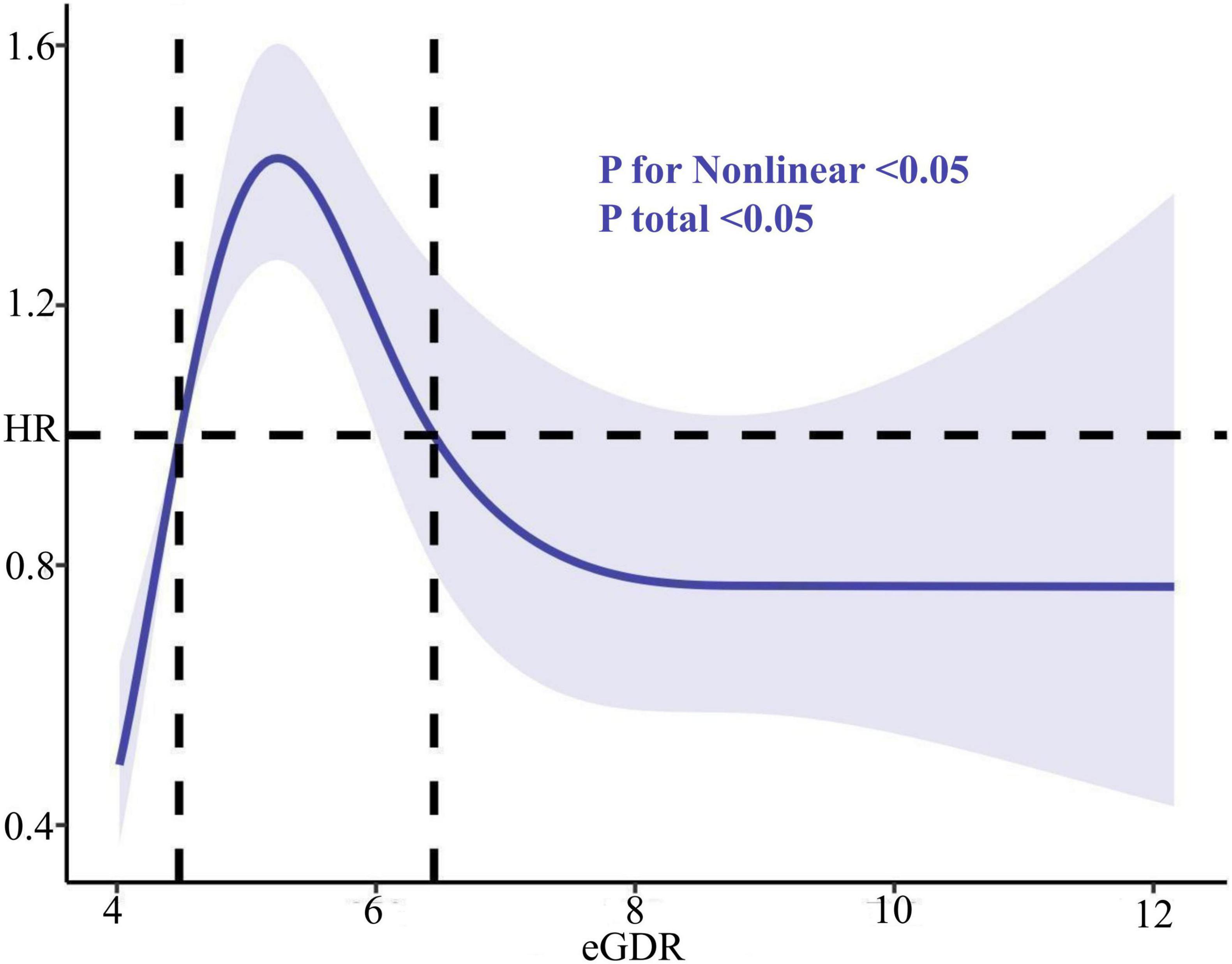
Figure 2. Association of eGDR and the risk of cognitive impairment using a multivariable-adjusted restricted cubic spines model. Restricted cubic spline analysis has four knots at the 5th, 35th, 65th, and 95th percentiles of eGDR. eGDR, estimated glucose disposal rate.
Cox proportional hazards and Kaplan-Meier survival analysis of the association between eGDR and cognitive impairment
The Cox proportional hazards models demonstrated an inverse relationship between eGDR and cognitive impairment risk. Progressive multivariable adjustment revealed consistent associations: each unit reduction in eGDR corresponded to a 21.8% lower risk (HR = 0.792, 95%CI: 0.745–0.801, P = 0.014) in the unadjusted model, 19.5% (hazard ratio [HR] = 0.805, 95% confidence interval [CI]: 0.795–0.818, P = 0.014) after demographic adjustment, and 15.8% (HR = 0.842, 95%CI: 0.793–0.881, P = 0.039) in the fully-adjusted model (Table 2). When analyzed categorically, the highest three eGDR quartiles showed non-significant protective trends (all HR < 1, P > 0.05) in Model III (Table 2). Supporting these findings, Kaplan-Meier curves displayed significant divergence in cognitive impairment incidence by eGDR quartile (log-rank P = 0.003), with progressively shorter median survival times observed in lower quartiles (Figure 3).

Table 2. Multivariate-adjusted hazard ratios (95% confidence intervals) of estimated glucose disposal rate for cognitive impairment.
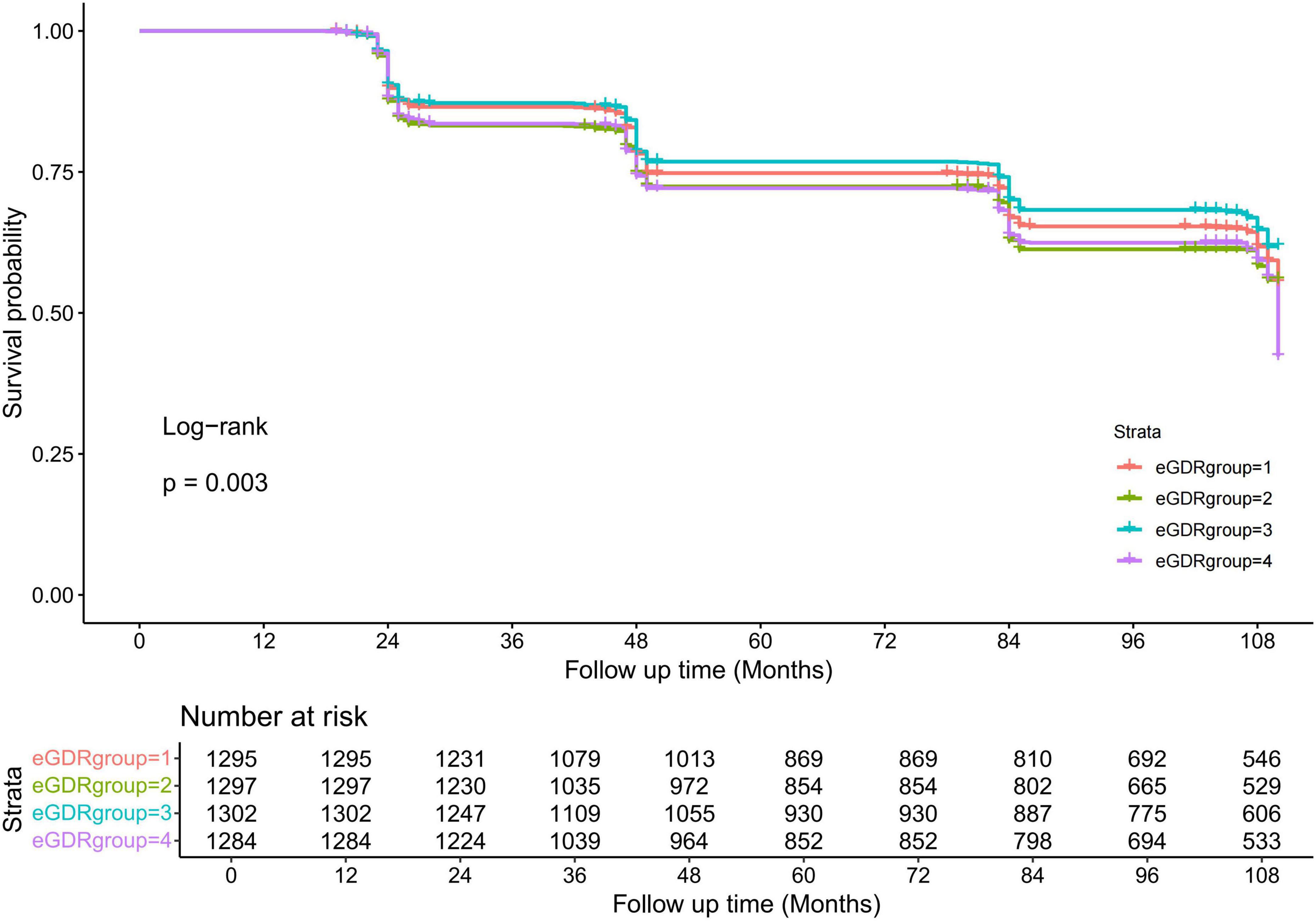
Figure 3. The Kaplan-Meier analysis for cognitive impairment was based on eGDR quartiles. eGDR, estimated glucose disposal rate.
Cox proportional hazards models comparing METS-IR, AIP, and TyG versus eGDR for CI risk
In the fully adjusted models, three metabolic indices demonstrated distinct associations with cognitive impairment. The metabolic score for insulin resistance (METS-IR) exhibited a significant inverse relationship, with each standard deviation increase corresponding to a reduced risk of cognitive impairment (HR = 0.99, 95%CI: 0.98–1.00, P = 0.002) (Supplementary Table 2). This protective effect was more pronounced in the quartile analyses, where participants in the highest METS-IR quartile had an 18% lower risk of cognitive impairment compared to those in the lowest quartile (HR = 0.82, 95%CI: 0.72–0.94, P = 0.005) (Supplementary Table 2). For the atherogenic index of plasma (AIP), linear regression analysis revealed a non-significant trend (HR = 0.90, 95%CI: 0.78–1.05, P = 0.170), although participants in the highest AIP quartile approached marginal significance (HR = 0.89, 95%CI = 0.78–1.02, P = 0.100) (Supplementary Table 3). In contrast, the triglyceride glucose index (TyG) demonstrated a near-significant linear association with cognitive impairment risk (HR = 0.85, 95% CI: 0.72–1.00, P = 0.050), with participants in the highest TyG quartile showing robust protection against cognitive impairment (HR = 0.83, 95%CI: 0.73–0.95, P = 0.010) (Supplementary Table 4).
Subgroup analysis
The association between eGDR and cognitive impairment risk demonstrated significant heterogeneity by smoking status. Among never-smokers, each SD increment in eGDR corresponded to a 12.2% lower risk (HR = 0.822, 95%CI: 0.784–0.861, P = 0.038). Smokers showed a similar but non-significant inverse relationship (P = 0.216), with significant between-group heterogeneity (pinteraction = 0.023). No significant effect modification was observed for age, sex, or alcohol consumption (all pinteraction > 0.05, Table 3).
Sensitivity analysis
Sensitivity analyses using alternative modeling approaches consistently showed modest associations between continuous eGDR measurements and cognitive outcomes (Table 4). Both models produced comparable effect estimates, reinforcing the primary findings while demonstrating robustness to different analytical specifications.
Discussion
This investigation demonstrates that both the eGDR and METS-IR show similar predictive value for cognitive impairment risk, while outperforming other metabolic indices including the TyG and AIP. These results suggest that comprehensive measures of insulin sensitivity provide better prognostic capability than lipid-focused metrics for assessing cognitive risk. The comparable performance of these two insulin sensitivity markers emphasizes the fundamental role of insulin resistance in cognitive decline, consistent with their common physiological basis in glucose metabolism regulation (19–22). In contrast, the TyG displays only modest predictive ability, indicating its more limited capacity to reflect the complex metabolic dysfunction associated with neurodegeneration. Similarly, the AIP shows the weakest association, suggesting that lipid-centered evaluations offer comparatively less insight into cognitive trajectory modulation than measures of insulin-glucose homeostasis.
The role of insulin resistance in metabolic disorders is well-established, and it is now being more commonly linked to neurodegenerative processes. Studies have documented that insulin resistance adversely affects cognitive function, particularly in populations at risk for metabolic syndrome or diabetes (1, 4–6, 23–25). Reflecting the current literature, our research highlights the crucial role of insulin sensitivity in cognitive health, suggesting that eGDR may serve as a significant marker for assessing cognitive risk in individuals without diabetes. In contrast to studies that depend only on fasting glucose or HbA1c, eGDR includes extra factors such as waist size and blood pressure, giving a fuller picture of insulin resistance (26, 27). The analysis of subgroups uncovered a significant association between eGDR and cognitive impairment risk in non-smokers, whereas this was not the case for smokers, implying a potential interaction effect. Non-smokers with lower eGDR levels had a higher risk of cognitive impairment, while smokers did not exhibit this pattern. Smoking is known to exacerbate oxidative stress and vascular inflammation, which may interact with insulin resistance in complex ways, potentially diminishing the observable impact of eGDR on cognitive impairment in this subgroup (27). Future research could further elucidate the biological interactions between smoking and insulin resistance in relation to cognitive health. Significant differences in survival without cognitive impairment across eGDR quartiles were shown by the Kaplan-Meier survival analysis, with participants in higher quartiles (indicating lower insulin resistance) experiencing longer periods free from cognitive impairment. These findings underscore the cumulative impact of metabolic health on cognitive outcomes over time, reinforcing the notion that insulin sensitivity plays a protective role against cognitive decline. This aligns with studies suggesting that maintaining metabolic health can delay or prevent the onset of neurodegenerative diseases (28–31). The sensitivity analyses, which included models adjusting for various potential confounders, confirmed the robustness of our findings. The relationship between eGDR and cognitive impairment risk was stable across these models, even after redefining diabetes solely by FBG and HbA1c levels and excluding those with early cognitive decline. This research highlights eGDR’s effectiveness as a predictor of cognitive impairment risk, especially among non-diabetic groups. However, additional longitudinal studies with more refined insulin resistance measures may further strengthen these findings.
This study has several limitations. First, while we controlled for multiple confounders, unmeasured factors may still influence the observed relationships. Second, eGDR was only measured at baseline, limiting our ability to observe changes in insulin resistance over time. Furthermore, using self-reported data on health behaviors, including smoking and alcohol use, could result in biases in reporting. Lastly, the generalizability of our findings may be limited to non-diabetic populations within a specific age range, underscoring the need for studies in diverse cohorts. Future research could focus on longitudinal changes in eGDR and their relationship with cognitive outcomes, particularly in populations at risk for both metabolic and cognitive disorders. Studying the biological pathways that associate insulin resistance with cognitive impairment may also offer valuable insights into targeted interventions. Moreover, examining the interaction effects of lifestyle factors, such as smoking and dietary habits, on the insulin resistance-cognitive impairment relationship could guide more personalized preventive strategies.
Conclusion
These findings suggest that elevated insulin resistance, as reflected by reduced eGDR levels, may represent a modifiable risk factor for cognitive decline in non-diabetic middle and older adults. The observed correlation underscores the potential of eGDR measurements in cognitive risk assessment, necessitating further research to clarify its role in predictive modeling and to inform strategies for maintaining cognitive health in aging populations.
Data availability statement
The original contributions presented in this study are included in this article/Supplementary material, further inquiries can be directed to the corresponding author.
Ethics statement
The studies involving humans were approved by Biomedical Ethics Review Committee of Peking University (IRB00001052-11015). The studies were conducted in accordance with the local legislation and institutional requirements. The participants provided their written informed consent to participate in this study.
Author contributions
BW: Conceptualization, Data curation, Formal Analysis, Investigation, Methodology, Project administration, Resources, Software, Supervision, Validation, Visualization, Writing – original draft, Writing – review and editing. FX: Conceptualization, Data curation, Formal Analysis, Investigation, Methodology, Resources, Software, Supervision, Validation, Visualization, Writing – original draft, Writing – review and editing. MZ: Conceptualization, Data curation, Formal Analysis, Investigation, Methodology, Software, Supervision, Validation, Visualization, Writing – original draft, Writing – review and editing.
Funding
The author(s) declare that no financial support was received for the research and/or publication of this article.
Acknowledgments
We sincerely thank Peking University for granting access to the CHARLS data. Additionally, we extend our heartfelt gratitude to all individuals involved in the collection, management, and maintenance of the CHARLS dataset, whose invaluable efforts have significantly contributed to the success of this research.
Conflict of interest
The authors declare that the research was conducted in the absence of any commercial or financial relationships that could be construed as a potential conflict of interest.
Generative AI statement
The authors declare that no Generative AI was used in the creation of this manuscript.
Publisher’s note
All claims expressed in this article are solely those of the authors and do not necessarily represent those of their affiliated organizations, or those of the publisher, the editors and the reviewers. Any product that may be evaluated in this article, or claim that may be made by its manufacturer, is not guaranteed or endorsed by the publisher.
Supplementary material
The Supplementary Material for this article can be found online at: https://www.frontiersin.org/articles/10.3389/fmed.2025.1522028/full#supplementary-material
References
1. Mao Y, Zhong W. Insulin resistance is associated with cognitive decline in type 1 diabetes mellitus. Acta Diabetol. (2022) 59:571–3. doi: 10.1007/s00592-021-01846-z
2. Abbasi F, Robakis T, Myoraku A, Watson K, Wroolie T, Rasgon N. Insulin resistance and accelerated cognitive aging. Psychoneuroendocrinology. (2023) 147:105944. doi: 10.1016/j.psyneuen.2022.105944
3. Cui Y, Tang T, Lu C, Ju S. Insulin resistance and cognitive impairment: Evidence from neuroimaging. J Magn Reson Imaging. (2022) 56:1621–49. doi: 10.1002/jmri.28358
4. Jaganathan R, Ravindran R, Dhanasekaran S. Emerging role of adipocytokines in type 2 diabetes as mediators of insulin resistance and cardiovascular disease. Can J Diabetes. (2018) 42:446–6.e1. doi: 10.1016/j.jcjd.2017.10.040
5. Liu FJ, Chang LL, Wang WL, Li JY. [Hepatic insulin resistance and type 2 diabetes mellitus]. Zhongguo Yi Xue Ke Xue Yuan Xue Bao. (2022) 44:699–708. doi: 10.3881/j.issn.1000-503X.13662
6. Padilla J, Manrique-Acevedo C, Martinez-Lemus L. New insights into mechanisms of endothelial insulin resistance in type 2 diabetes. Am J Physiol Heart Circ Physiol. (2022) 323:H1231–8. doi: 10.1152/ajpheart.00537.2022
7. Matsuda M. Measuring and estimating insulin resistance in clinical and research settings. Nutr Metab Cardiovasc Dis. (2010) 20:79–86. doi: 10.1016/j.numecd.2009.07.007
8. Choi J, Lee M, Fujii T. Insulin resistance and microalbuminuria in patients with impaired fasting glucose versus hemoglobin A1c-defined prediabetes. Ann Clin Lab Sci. (2022) 52:802–10.
9. Saraswati M, Nugraha I, Suastika K. Similar blood glucose pattern with highest peak at minute 45 on oral glucose tolerance test despite higher fasting insulin and insulin resistance in healthy obese than non-obese subject. Acta Med Indones. (2022) 54:210–7. doi: 10.2154/clin.5471
10. Yin B, Ding L, Chen Z, Chen Y, Zhu B, Zhu Y. Combining HbA1c and insulin resistance to assess the risk of gestational diabetes mellitus: A prospective cohort study. Diabetes Res Clin Pract. (2023) 199:110673. doi: 10.1016/j.diabres.2023.110673
11. Ren X, Jiang M, Han L, Zheng X. Estimated glucose disposal rate and risk of cardiovascular disease: Evidence from the China health and retirement longitudinal study. BMC Geriatr. (2022) 22:968. doi: 10.1186/s12877-022-03689-x
12. Chen W, Liu Y, Shi Y, Liu J. Prognostic value of estimated glucose disposal rate and systemic immune-inflammation index in non-diabetic patients undergoing PCI for chronic total occlusion. J Cardiovasc Dev Dis. (2024) 11:261. doi: 10.3390/jcdd11090261
13. Peng J, Zhang Y, Zhu Y, Chen W, Chen L, Ma F, et al. Estimated glucose disposal rate for predicting cardiovascular events and mortality in patients with non-diabetic chronic kidney disease: A prospective cohort study. BMC Med. (2024) 22:411. doi: 10.1186/s12916-024-03582-x
14. Koken ÖY, Kara C, Yılmaz GC, Aydın HM. Utility of estimated glucose disposal rate for predicting metabolic syndrome in children and adolescents with type-1 diabetes. J Pediatr Endocrinol Metab. (2020) 33:859–64. doi: 10.1515/jpem-2020-0012
15. Yao J, Zhou F, Ruan L, Liang Y, Zheng Q, Shao J, et al. Association between estimated glucose disposal rate control level and stroke incidence in middle-aged and elderly adults. J Diabetes. (2024) 16:e13595. doi: 10.1111/1753-0407.13595
16. Zhao Y, Hu Y, Smith J, Strauss J, Yang G. Cohort profile: The China health and retirement longitudinal study (CHARLS). Int J Epidemiol. (2014) 43:61–8. doi: 10.1093/ije/dys203
17. Liu H, Zou L, Zhou R, Zhang M, Gu S, Zheng J, et al. Long-term increase in cholesterol is associated with better cognitive function: Evidence from a longitudinal study. Front Aging Neurosci. (2021) 13:691423. doi: 10.3389/fnagi.2021.691423
18. Zhou S, Song S, Jin Y, Zheng Z. Prospective association between social engagement and cognitive impairment among middle-aged and older adults: Evidence from the China Health and Retirement Longitudinal Study. BMJ Open. (2020) 10:e040936. doi: 10.1136/bmjopen-2020-040936
19. Biessels G, Whitmer R. Cognitive dysfunction in diabetes: How to implement emerging guidelines. Diabetologia. (2020) 63:3–9. doi: 10.1007/s00125-019-04977-9
20. Lei M, Guo X, Yao Y, Shu T, Ren Z, Yang X, et al. Trelagliptin relieved cognitive impairment of diabetes mellitus rats: Involvement of PI3K/Akt/GSK-3β and inflammation pathway. Exp Gerontol. (2023) 182:112307. doi: 10.1016/j.exger.2023.112307
21. De Felice F, Ferreira S. Inflammation, defective insulin signaling, and mitochondrial dysfunction as common molecular denominators connecting type 2 diabetes to Alzheimer disease. Diabetes. (2014) 63:2262–72. doi: 10.2337/db13-1954
22. Edgerton-Fulton M, Ergul A. Vascular contributions to cognitive impairment/dementia in diabetes: Role of endothelial cells and pericytes. Am J Physiol Cell Physiol. (2022) 323:C1177–89. doi: 10.1152/ajpcell.00072.2022
23. Wang C, Huang X, Tian S, Huang R, Guo D, Lin H, et al. High plasma resistin levels portend the insulin resistance-associated susceptibility to early cognitive decline in patients with type 2 diabetes mellitus. J Alzheimers Dis. (2020) 75:807–15. doi: 10.3233/JAD-200074
24. Neergaard J, Dragsbæk K, Christiansen C, Nielsen H, Brix S, Karsdal M, et al. Metabolic syndrome, insulin resistance, and cognitive dysfunction: Does your metabolic profile affect your brain? Diabetes. (2017) 66:1957–63. doi: 10.2337/db16-1444
25. Ezkurdia A, Ramírez M, Solas M. Metabolic syndrome as a risk factor for Alzheimer’s disease: A focus on insulin resistance. Int J Mol Sci. (2023) 24:4354. doi: 10.3390/ijms24054354
26. Epstein E, Osman J, Cohen H, Rajpathak S, Lewis O, Crandall J. Use of the estimated glucose disposal rate as a measure of insulin resistance in an urban multiethnic population with type 1 diabetes. Diabetes Care. (2013) 36:2280–5. doi: 10.2337/dc12-1693
27. Šimonienë D, Platûkiene A, Prakapienë E, Radzevièienë L, Velièkiene D. Insulin resistance in Type 1 Diabetes mellitus and its association with patient’s micro- and macrovascular complications, sex hormones, and other clinical data. Diabetes Ther. (2020) 11:161–74. doi: 10.1007/s13300-019-00729-5
28. Hu X, Peng J, Tang W, Xia Y, Song P. A circadian rhythm-restricted diet regulates autophagy to improve cognitive function and prolong lifespan. Biosci Trends. (2023) 17:356–68. doi: 10.5582/bst.2023.01221
29. Whyte A, Rahman S, Bell L, Edirisinghe I, Krikorian R, Williams C, et al. Improved metabolic function and cognitive performance in middle-aged adults following a single dose of wild blueberry. Eur J Nutr. (2021) 60:1521–36. doi: 10.1007/s00394-020-02336-8
30. Grigolon R, Brietzke E, Trevizol A, McIntyre R, Mansur R. Caloric restriction, resting metabolic rate and cognitive performance in Non-obese adults: A post-hoc analysis from CALERIE study. J Psychiatr Res. (2020) 128:16–22. doi: 10.1016/j.jpsychires.2020.05.018
Keywords: cognitive impairment, estimated glucose disposal rate, insulin resistance, diabetes mellitus, CHARLS
Citation: Wang B, Xu F and Zhang M (2025) Evaluating the link between insulin resistance and cognitive impairment using estimated glucose disposal rate in a non-diabetic aging population: results from the CHARLS. Front. Med. 12:1522028. doi: 10.3389/fmed.2025.1522028
Received: 03 November 2024; Accepted: 02 May 2025;
Published: 05 June 2025.
Edited by:
Aivaras Ratkevicius, Queen Mary University of London, United KingdomReviewed by:
Rodrigo Augusto Foganholi Da Silva, Paulista University, BrazilSimona Georgiana Popa, University of Medicine and Pharmacy of Craiova, Romania
Copyright © 2025 Wang, Xu and Zhang. This is an open-access article distributed under the terms of the Creative Commons Attribution License (CC BY). The use, distribution or reproduction in other forums is permitted, provided the original author(s) and the copyright owner(s) are credited and that the original publication in this journal is cited, in accordance with accepted academic practice. No use, distribution or reproduction is permitted which does not comply with these terms.
*Correspondence: Minheng Zhang, em1oZmh4QDE2My5jb20=
†These authors have contributed equally to this work and share first authorship
 Bingqing Wang
Bingqing Wang Fei Xu
Fei Xu Minheng Zhang
Minheng Zhang